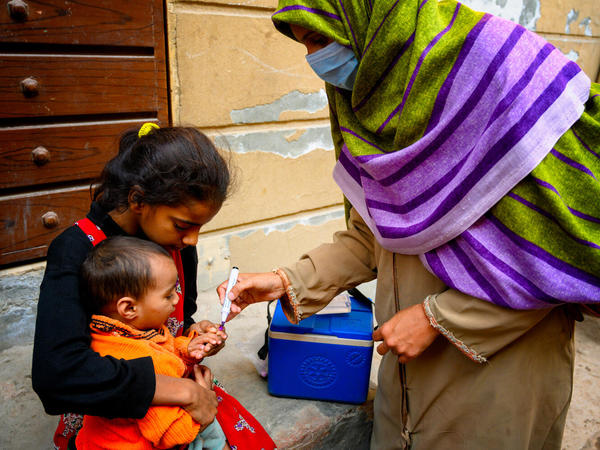Social data can provide essential layers of explanation, nuance and detail to epidemiological and other programme data. It helps to answer who the children are being missed, why they are being missed, and may contribute to better understanding of parents’ attitudes, perceptions and preventive health behavior. Social data also informs development of programme interventions to better engage parents and communities.
Learning, for example, that 10% of children have been missed in a given district is only the first layer of the analysis. Unpacking this number by continually asking "why" through social data collection will reveal more detail and often tactics to resolve the issue.
The 10% may turn out to be mainly refusals. Why are they refusing? Perhaps because the team composition was not appropriate. Why? Perhaps because the local culture does not allow unaccompanied women to enter the household.
Corrective actions in this case could include new recruitment of teams to include both men and women, better IPC training of vaccinators, and seeking opportunities where mothers can be mobilized and encouraged to expect and demand the vaccine.
Social data help us better understand the root reasons for absences or refusals. The data also help us identify influential opinion-makers in high risk areas, as well as the main social and cultural bottlenecks to vaccine acceptance.
People are guided by social norms as well as by their social and cultural practices and beliefs. Individual decision-making must be understood within the context of both the social rules of behavior, as well as long-established practices and beliefs.
There are many different methodologies and tools for social data collection. These may be quantitative, qualitative, or mixed design, such as social case profiling, and the special investigation for missed children.
- Quantitative (Knowledge, Attitude, and Practice studies) - surveys
- Qualitative Studies (anthropological, ethnographic, and mobile population studies) – desk and literature reviews, focus groups, in-depth interviews, observations
- Polio and AFP Case Profiles (Social profiling, special investigations) – mixed design
Understanding their strengths and weaknesses is essential in using them to their greatest impact.
| Quantitative | Qualitative | Mixed design |
|---|---|---|
|
Pros:
|
Pros:
|
Pros:
|
|
Cons:
|
Cons:
|
Cons:
|
Quantitative
While there are many good examples of KAP studies, over the past years UNICEF has been partnering with the Harvard School of Public Health to develop robust research methodology to elucidate key behavioural determinants that create an enabling environment for polio campaigns. The representative sampling, comprehensive research tool with tested constructs and scales, and thorough field supervision during the data collection process produce reliable and valid measurements of community awareness, acceptance, trust, and credibility of polio immunization. Click here to learn more about this polling programme and samples of research instruments.
Qualitative
There are many examples of qualitative research studies in the polio programme that revealed in-depth insights on barriers towards polio immunization through individual and group discussions, observation of the context, and cultural practices. Therefore, these studies are often very specific to regions, countries, and even certain groups of interest. UNICEF also holds LTAs with 11 vetted top-of-the-line research and analysis companies that allow quick and easy contracting. Click here to visit the LTA section of the toolkit.
Mixed design
Confirmed poliovirus or AFP case investigation is a GPEI unique methodology of mixed design that provides epidemiological and social data about polio-affected families and the community. A multi-disciplinary team of epidemiologists, clinicians, laboratory, vaccine management, social mobilization, and communication professionals of the government, UNICEF, and WHO are deployed to conduct detailed comprehensive examination as per defined GPEI standards. Agencies may take the lead in particular areas. For example, UNICEF will normally take a lead in the Community Assessment component of the investigation. The absence of anyone partner should be explained and documented.
The detailed case investigation report provides a wealth of data on the circumstances of the confirmed case. This data, along with other aspects of the programme, informs communication planning for the vaccination response. It is therefore critical to conduct the investigation jointly to ensure that both epidemiological and social risk factors of the child, family, and community are well-understood.
The GPEI Detailed Investigation Form can be found here.
In situations of concern, such as identified clusters of WPV/cVDPV, zero-dose AFP, persistently missed children, and refusals, a special investigation may be needed in addition to the detailed case investigation. This exercise helps GPEI to collect additional information to elucidate underlying reasons that lead to chronically missing children.
The GPEI Special Investigation tool is composed of three distinct sections:
PARTS A and B are designed to evaluate the planning of SIAs, staff capacity, accountability, and leadership at the district (PART A) and sub-district levels (PART B). These parts review micro plans and documents related to planning and preparatory activities (e.g. funding, meetings, training) conducted prior to the most recent polio SIA and also include rapid interviews with selected field staff.
PART C is designed to assess community perceptions and attitudes towards the polio program and the vaccine, as well as the wider routine immunization system. It focuses on the community that triggered the investigation and includes rapid interviews with one local, traditional, or religious leader of that community and a cluster survey of 20 households in the community.
Learn more
Explore the other two learning modules in this 3-step tutorial to design evidence-driven communication strategies to help vaccinate every child.
Integrate communications tactics and understand their strengths and weaknesses, then evaluate performance.
Define your target audience and barriers to change, then develop messages and choose channels to reach your audience.



